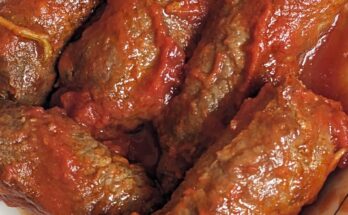Delicate, tender, and kissed with the unmistakable aroma of anise, these Italian Anise Cookies are a true classic in traditional Italian baking.
Soft and pillowy on the inside with a lightly sweet icing on top, they carry the nostalgic charm of holiday gatherings and family celebrations. The subtle licorice flavor of anise makes them unique—bold yet refined—while the cheerful sprinkle of nonpareils adds festive flair.
Perfect for Christmas trays, Easter spreads, or simply with a cup of coffee, these cookies embody both comfort and tradition in every bite.

Why People Will Love Italian Anise Cookies:
Unique, aromatic flavor – the gentle licorice-like essence of anise offers a taste that’s both traditional and memorable, setting these cookies apart from everyday sweets.
Soft, tender texture – light and pillowy on the inside, with a delicate bite that feels comforting and satisfying.
Festive appearance – the glossy icing and colorful nonpareils create a cheerful, celebratory look that brightens any dessert table.
Timeless tradition – these cookies carry the charm of Italian heritage, often passed down through generations, making them feel meaningful as well as delicious.
Versatile enjoyment – perfect for holiday trays, family gatherings, or simply alongside a warm cup of coffee or tea.
Balanced sweetness – not overly sugary, allowing the anise flavor to shine while still offering a satisfying treat.
Crowd-pleasing adaptability – while anise is classic, the recipe can be customized with vanilla or almond extract for different tastes.
Key Ingredient:
Unsalted butter – provides a rich, creamy base that creates tenderness and carries the subtle flavors of the cookie.
Eggs – add structure and moisture, giving the cookies their soft, pillowy interior.
All-purpose flour with baking powder – the backbone of the dough, offering lightness and helping the cookies rise just enough for a delicate, airy bite.
Anise extract – the signature ingredient, infusing each cookie with its distinct licorice-like aroma and timeless Italian character.
Powdered sugar and milk icing – creates a sweet, smooth glaze that balances the anise flavor and adds a glossy finish.
Nonpareils – not just decorative, but symbolic of celebration, bringing color and festive charm to the cookies.
Expert Tips:
Soften butter properly – let the butter come fully to room temperature before mixing. If it’s too cold, the dough won’t cream correctly; if it’s melted, the cookies will spread too much.
Beat until fluffy – when creaming the butter, sugar, and salt, whip until pale and airy (2–3 minutes). This incorporates air into the dough, ensuring light, tender cookies.
Add eggs one at a time – fully incorporate each egg before adding the next to avoid a heavy or curdled batter. This helps create a smooth, cohesive dough.
Don’t overmix the flour – once the dry ingredients go in, mix only until just combined. Overmixing can make the cookies tough instead of soft and cake-like.
Chill the dough – even though it’s a quick dough, that 30-minute rest firms it up, making it easier to roll and helping the cookies hold their shape while baking.
Rotate baking sheets – switching the pans top to bottom and front to back halfway through ensures even baking and consistent color.
Cool before icing – the cookies must be completely cool before dipping in icing, or the glaze will melt and run off instead of setting.
Let the icing set fully – give the cookies at least 1 hour to dry; this keeps the glaze glossy and prevents smudging when stacked or stored.

Italian Anise Cookies
Ingredients:
FOR THE COOKIES:
1 stick unsalted butter (8 tablespoons)
3 large eggs
2 1/2 cups all-purpose flour
2 teaspoons baking powder
1/2 cup granulated sugar
1/4 teaspoon kosher salt
2 teaspoons anise extract
FOR THE ICING:
1 cup powdered sugar
2 tablespoons whole or 2% milk
1/4 teaspoon anise extract
1 tablespoon nonpareils
Instructions
Make the Cookies:
Cut the butter into pieces and place it in the bowl of a stand mixer (or large bowl for a hand mixer). Set the butter and eggs out at room temperature for about 1 hour, until the butter softens.
In a medium bowl, whisk together the flour and baking powder. Set aside.
Add the sugar and salt to the softened butter. Beat on high speed with the paddle attachment until the mixture is light and fluffy, 2–3 minutes. Scrape down the sides of the bowl as needed.
Beat in the eggs, one at a time, making sure each egg is fully incorporated before adding the next.
Mix in the anise extract on medium speed until combined.
On low speed, gradually add the flour mixture. Beat just until the dough comes together, about 30–45 seconds.
Cover the bowl and refrigerate the dough for 30 minutes. Meanwhile, preheat the oven to 350°F and line 2 rimmed baking sheets with parchment paper.
Scoop 1-tablespoon portions of dough, roll into balls, and arrange on the baking sheets about 1½ inches apart (up to 20 per sheet).
Bake for 5 minutes, then rotate the pans top to bottom and front to back. Bake another 5 minutes, or until the cookies are cracked on top and lightly golden on the bottom.
Let cool on the sheets for 5 minutes, then transfer to wire racks to cool completely.
Make the Icing:
In a small bowl, whisk together the powdered sugar, milk, and anise extract until smooth.
Place the wire rack of cooled cookies over a baking sheet. Dip the tops of the cookies into the icing, letting excess drip off, and place back on the rack.
Sprinkle with nonpareils, if using. Allow cookies to sit at least 1 hour for the icing to set fully.
Important Notes When Making Italian Anise Cookies:
Butter and eggs must be at room temperature – this ensures proper creaming, which directly impacts the texture. Cold butter or eggs will prevent the dough from mixing evenly.
The anise extract is the star – measure carefully. Too much can overwhelm with a sharp licorice flavor, while too little won’t give the cookies their distinct Italian character.
Chilling time matters – resting the dough in the fridge helps it firm up, which makes rolling easier and prevents excessive spreading during baking.
Do not overbake – these cookies are meant to stay soft and tender. Pull them from the oven once the tops crack and the bottoms show a hint of golden brown. Overbaking will make them dry.
Cool fully before icing – warm cookies will melt the glaze, making it runny and preventing it from setting properly.
Icing thickness is adjustable – add a touch more milk for a thinner glaze or extra powdered sugar for a thicker coating, depending on your preference.
Nonpareils are optional but traditional – they give the cookies a festive, celebratory appearance, especially during holidays, but you can swap them for other sprinkles or leave them plain.
Storage improves flavor – keep cookies in an airtight container at room temperature for a few days. The anise flavor deepens over time, making them even more delicious.
How To Enjoy Italian Anise Cookies After Cooking:
Serving Suggestions
With coffee or espresso – the subtle licorice note of anise pairs beautifully with a strong, bitter coffee or a foamy cappuccino.
As a holiday centerpiece – arrange on a platter with other Italian classics like biscotti, pizzelle, or amaretti for a festive cookie tray.
Everyday treat – perfect as an afternoon snack with tea or milk, or as a light dessert after dinner.
Gift idea – pack in decorative tins or cellophane bags with ribbons; their festive look makes them wonderful for sharing with friends and family.
Flavor Pairings
Wine pairing – try with a sweet dessert wine like Vin Santo or Moscato; the sweetness complements the delicate anise flavor.
Fruit pairing – serve alongside fresh berries or citrus segments for a refreshing contrast.
Cheese pairing – for a unique touch, pair with a mild creamy cheese like mascarpone for a balance of savory and sweet.
Occasions
Holiday traditions – especially at Christmas and Easter, these cookies are a staple in many Italian households.
Celebrations – birthdays, weddings, or family gatherings where colorful, joyful cookies bring a sense of festivity.
Everyday indulgence – not just for special occasions, they’re light enough to be enjoyed anytime.
Enjoyment Tips
Allow icing to set fully – wait at least 1 hour before stacking or storing, otherwise the glaze may smudge.
Best fresh, better with time – the cookies taste wonderful the day they’re made but become even more flavorful after resting a day or two, as the anise intensifies.
Serve at room temperature – this keeps the icing smooth and the texture tender.
Nutrition Information:
(Approximate, per 1 cookie, out of 40 total) for Italian Anise Cookies:
Calories: 70 kcal | Total Fat: 3.5 g | Saturated Fat: 2 g | Monounsaturated Fat: 1 g | Polyunsaturated Fat: 0.3 g | Cholesterol: 20 mg | Sodium: 20 mg | Total Carbohydrates: 9 g | Dietary Fiber: 0 g | Sugars: 4 g | Protein: 1 g
Frequently Asked Questions:
What makes Italian Anise Cookies different from other holiday cookies?
Italian Anise Cookies stand out because of the anise extract, which gives them a distinctive licorice-like flavor deeply tied to Italian baking traditions. Combined with the light, pillowy texture and festive icing with nonpareils, they’re as much about cultural heritage as flavor.
Can I adjust the flavor if I don’t like anise?
Yes! While anise is traditional, you can substitute it with almond, vanilla, or even lemon extract. Each option creates a unique twist without losing the soft texture of the cookie.
Why is chilling the dough important in this recipe?
Chilling the dough allows the butter to firm up, which prevents the cookies from spreading too much during baking. It also helps the flavors meld together, giving you more depth in every bite.
How do I achieve the perfect icing consistency?
The icing should be thick enough to coat the cookie tops without running off, yet thin enough to set into a smooth glaze. If it’s too thick, add a few drops of milk; if too thin, whisk in a little more powdered sugar.
How long will these cookies stay fresh?
Stored in an airtight container at room temperature, they will stay fresh for 4–5 days. For longer storage, they can be frozen (without icing) for up to 2 months, then thawed and glazed before serving.
Do I really need to use unsalted butter for this recipe?
Yes, unsalted butter is preferred because it allows you to control the salt level precisely. If you only have salted butter, reduce the added kosher salt to avoid an overly salty flavor.
Why do I have to add the eggs one at a time?
Adding eggs individually ensures each one emulsifies fully with the butter and sugar. This step creates a stable, airy structure that leads to the soft, pillowy texture these cookies are known for.
How can I tell when the cookies are baked perfectly?
The tops should be slightly cracked, and the bottoms should show a faint golden color. Overbaking will make them dry and crumbly, while underbaking may leave them too soft and dense.
Can I make the dough ahead of time?
Absolutely. The dough can be refrigerated for up to 24 hours before baking. If it’s too firm when ready to use, let it sit at room temperature for 10–15 minutes to soften slightly before scooping.
Why is it important to cool the cookies before icing them?
If the cookies are still warm, the icing will melt and run off, resulting in a messy finish. Cooling completely ensures the icing sets beautifully and holds the sprinkles in place.



